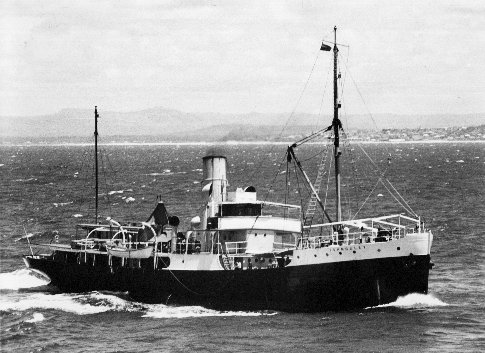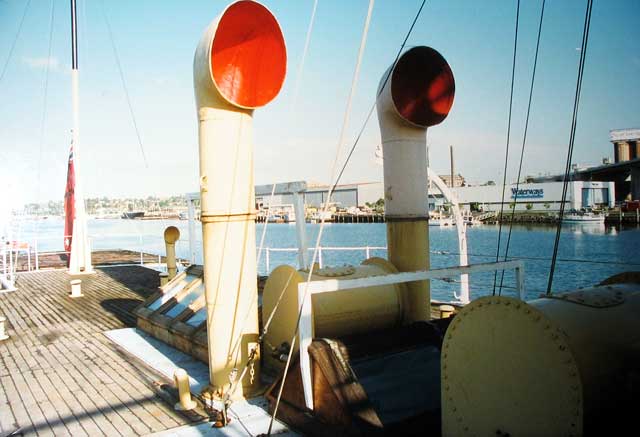Fire Onboard the S.S. John Oxley in 1967
By Don Tracey
The Queensland Harbours and Marine, a branch of the Queensland State government is charged with the task of maintaining the navigation waterways and harbours for the entire Queensland coast, and the steamship John Oxley was employed in maintaining the upkeep of the buoyage system from Port Douglas to the Port of Brisbane and all ports in between.
My name is Don Tracey, and I joined the Harbours and Marine department as a deckhand in the marine survey gang in 1957, on my 24th birthday, which was the day following my discharge from the Australian navy, after six years of service, which included a 1953 stint in Korea on the frigate HMAS Murchison.
During the period from 1957 to 1972, I served in a deck officer capacity on many of the Department’s vessels, and was appointed in 1967 as Master of the John Oxley and the Brisbane Pilot vessel Matthew Flinders.
These two vessels had alternating crews, who served one week on the pilot vessel on station at Caloundra, and the other week in the same capacity on the John Oxley for navigation mark maintenance.
 My first trip as Master of the John Oxley was to replace several large Moreton Bay channel buoys. Naturally I had some trepidations about handling this vessel for the first time, as from the position of Chief mate on previous trips, I had seen the skill required by the skipper and crew, to anchor and lay alongside a buoy, taking into account wind and tide effects.
My first trip as Master of the John Oxley was to replace several large Moreton Bay channel buoys. Naturally I had some trepidations about handling this vessel for the first time, as from the position of Chief mate on previous trips, I had seen the skill required by the skipper and crew, to anchor and lay alongside a buoy, taking into account wind and tide effects.
We departed in the afternoon from the H & M docks located near the Brisbane Botanical Gardens, and preceded down river to the river entrance at southern end of Moreton Bay. The trip downriver was uneventful, and I found the vessel very easy to handle, due to the slow turning large propeller and the huge barn door rudder, these attributes made docking and undocking in the confines of the Brisbane River a fairly normal operation.
It was intended to commence work at daylight the following day to take advantage of calm conditions, prior to the normal northeast sea breeze that kicked most days in summer. Consequently the vessel was anchored just outside the river bar cut on the eastern side for the night.
I was awakened by the Chief Mate about 5 A.M. with the report that we had a fire in the stokehold. The Captain’s cabin was two decks above the stokehold and already there was considerable black smoke visible when I stepped onto the deck.
On arriving at the door down to stokehold, it was evident that we had a serious fire on our hand, as a large area of the deck plates were covered in burning oil. The crew were mustered to fire stations, but it was then found that the extinguishers were in the stokehold and could not be reached.
 The fire continued to grow and it was discovered that the stokehold axial vents, which were about ten feet tall on the boat deck, were acting as chimneys, and the updraft was adding to the fire’s intensity.
The fire continued to grow and it was discovered that the stokehold axial vents, which were about ten feet tall on the boat deck, were acting as chimneys, and the updraft was adding to the fire’s intensity.
This is when it was discovered that there were no dampers present in these vents, which is normal in most vessels. To stifle the vents, crew members removed the boat covers and managed to cover the vent outlets and thereby remove the updraft effect.
It was then learnt from the fireman, who had been charged with firing up the boilers after they had been banked for the night, that he had been installing an oil injection burner, as a normal practice, to fire up the boiler for the day’s work, which had been soaking in diesel oil overnight for cleaning.
Apparently the nozzle jet had been removed from the unit for cleaning and had not been replaced, this resulted in a low pressure stream of furnace oil from a one inch diameter hole being spilled around the aperture to the furnace, which quickly caused this fire, and it was not possible to reach the fuel oil pump in the stokehold to stop the flow of furnace fuel oil due to the intensity of the fire.
 After consulting with the Chief Engineer it was decided, as a last resort, to flood the engine room and stokehold with steam from the boilers. The piping layout did not permit steam flooding the stokehold alone, so consequently both areas had to be flooded.
After consulting with the Chief Engineer it was decided, as a last resort, to flood the engine room and stokehold with steam from the boilers. The piping layout did not permit steam flooding the stokehold alone, so consequently both areas had to be flooded.
This action removed all the oxygen from the fire and it was extinguished. However, this was dangerous for if it did not extinguish the fire, there were no other alternatives except to abandon the vessel.
As a result there was no steam left for any function on the vessel, so we remained at anchor to clean up the mess and fire up the boilers again. This was slowly accomplished and about lunchtime things were back to normal.
It fell on my shoulders, when the Harbour control office opened at 9 A.M., to inform the Harbour Master, Capt. Hildebrand, of the situation onboard the John Oxley.
This was not a welcome task, as this was my first time in command, I was considered very young at 36 years to be Master compared to other department captains, many of who were markedly older than myself. However the Capt, Hildebrand’s main concern was when could we proceed and carry out the scheduled buoy maintenance.
We completed the scheduled work and returned later that week, to allow the crew and myself to have one night at home and prepare to leave on the Friday, as relief crew for the Matthew Flinders for a week of pilotage duties, rolling around in the open swells off Caloundra at the mouth of Moreton Bay.
Both the John Oxley and the Matthew Flinders were decommissioned in 1968, and I, and many of these crews, went to man the fast 75 foot pilot launches operating from the new base in Mooloolaba.
In 1972, I left the Department and sailed to the USA on the Australian Maxi Yacht Ballyhoo and never came back to OZ and now live permanently in Fort Lauderdale, Florida, USA, except for annual visits to OZ to see my sons and their families.
Since then I have been self employed, and engaged in the construction of many luxury power and sail mega-yachts, in many different parts of the world, and to this date I am still enjoying this great life, and I owe thanks to the Harbours & Marine department for all the great experience I gained during my fifteen years of service.
I had the honor to visit the restoration site of the John Oxley in August 2005, and to meet several of the volunteers who are dedicated to this great project.
Keep up the good work.
Best Regards, Don Tracey, 7 September 2006.




